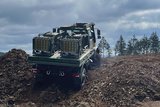British Army puts SlingShot into use
The British Army uses SlingShot as a bolt-on capability with the Bowman VHF radio. (Photo: Spectra Group)
The British Army has deployed the SlingShot tactical communications system, operating with the Inmarsat L-band Tactical Satellite service, as an additional capability alongside in-service Bowman VHF radios.
The result for troops is a BLoS communications capability ‘that would otherwise have only been available to more specialist units’, SlingShot manufacturer Spectra Group claimed in a 25 March announcement.
Maj Gen Jonathan Cole, Director of Information and CIO of the British Army, described SlingShot as a ‘game changer’ and ‘a fantastic addition to our communications inventory’.
SlingShot can be integrated with in-service UHF and VHF tactical communications systems to extend the range of radios from 30km to 1,000 km ‘on the move in all conditions’, the company added.
As well as BLoS voice, SlingShot includes a data capability with situational awareness tools, GPS tracking, reporting and other data messaging, without the requirement for ground-based LoS re-broadcasting infrastructure that requires the deployment of more troops.
Troops also travel lighter, Spectra claimed, as they no longer need to carry Bowman and UHF tactical SATCOM radios.
‘Both can now be carried out using the same radio,’ the company noted, adding that omnidirectional antennas with SlingShot enable communications on the move in real time.
As part of our promise to deliver comprehensive coverage to our Defence Insight and Premium News subscribers, our curated defence news content provides the latest industry updates, contract awards and programme milestones.
Related Equipment in Defence Insight
More from Digital Battlespace
-
![Babcock nears first customer for Nomad AI translation tool]()
Babcock nears first customer for Nomad AI translation tool
Nomad can provide militaries with real-time intelligence, saving critical time on the battlefield.
-
![AUSA 2025: Israel’s Asio Technologies to supply hundreds of improved Taurus tactical systems]()
AUSA 2025: Israel’s Asio Technologies to supply hundreds of improved Taurus tactical systems
Taurus operates alongside the Israel Defense Forces’ Orion system which supports mission management across tens of thousands of manoeuvring forces, from squad leaders to battalion commanders.
-
![AUSA 2025: Kopin pushes micro-LED plans as China moves faster]()
AUSA 2025: Kopin pushes micro-LED plans as China moves faster
The plan for the new displays follows fresh investment in Kopin’s European facilities by Theon and an order for head-up displays in fielded aircraft, with funding from the US Department of Defense.
-
![AUSA 2025: Persistent Systems to complete its largest order by year’s end]()
AUSA 2025: Persistent Systems to complete its largest order by year’s end
Persistent Systems received its largest ever single order for its MPU5 devices and other systems earlier this month and has already delivered the 50 units to the US Army’s 4th Infantry Division.
-
![Aselsan brings in dozens of companies and systems under the Steel Dome umbrella]()
Aselsan brings in dozens of companies and systems under the Steel Dome umbrella
Turkey has joined the family of countries attempting to establish a multilayered air defence system with government approval in August 2024 for the effort landed by Aselsan. Dubbed Steel Dome, the programme joins Israel’s Iron Dome, the US Golden Dome, India’s Mission Sudarshan Chakra and South Korea’s low-altitude missile defence system.
-
![DSEI 2025: MARSS unveils new agnostic multidomain C4 system]()
DSEI 2025: MARSS unveils new agnostic multidomain C4 system
MARSS’ NiDAR system has been deployed using sensors from static platforms to provide detection and protection for static sights, such as critical infrastructure, ports and military bases.




























